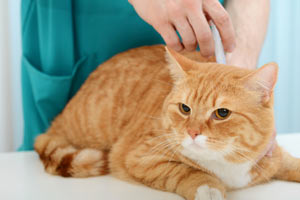Microchipping Your Cat

Ozzy the Ocicat darted through the open door as you were bringing in groceries. He disappeared into the night and didn't return. If someone finds him, will they know he's yours?
Hazel the Himalayan turned into Houdini and slithered out of her harness during your routine walk. Now she's been missing for two days. Was she mistaken for a stray? Did she end up at a local vet hospital or animal shelter?
If you've ever lost a cat, you know how absolutely dreadful the experience is.
Millions of cats are lost every year and end up in shelters. The statistics associated with finding lost cats' owners aren't good. According to the American Society for the Prevention of Cruelty to Animals (ASPCA), as few as 2% of lost cats are ever reunited with their families. When a cat is wearing some form of identification, the odds of finding the owners are better, but tags and collars can break, they can be removed by humans, and cats can get them off. In fact, it's safest if your cat wears a breakaway collar so she won't be choked if she gets it caught on something. So how can you increase your cat's odds of being returned to you if she gets lost?
The ASPCA states that, when used with a visible tag or collar, a microchip provides the most reliable means of recovering a lost pet.
How Microchips Work
A microchip is a radio-frequency identification (RFID) device that is about the size of a grain of rice. It has three parts: a small computer chip, some electronics, and a silicone capsule. The microchip is inserted under the cat's scruff (the loose skin between the shoulder blades) with a special needle and syringe. When it is activated by a handheld scanner, the chip emits an alphanumeric code that uniquely identifies the cat.
As soon as your cat's microchip is implanted, you need to register it with the chip's manufacturer. This step is critical. A microchip is not a tracking device. If your cat is ever lost and taken to a veterinary hospital, animal shelter, or another place that can scan her for a microchip, the code will come up on the scanner. The manufacturer's registry will then need to be contacted and the code given to them so they can look up your contact information. If you have failed to register the chip or keep your contact information current, the microchip will be of absolutely no help in reuniting you with your cat.
If you ever find a lost cat that isn't wearing tags, the best thing to do is call your local veterinarian or shelter to see if they can scan her for a microchip.
Uses and Benefits of Microchips
Today, microchips are used around the world as an efficient and safe way of identifying animals. Countries and municipalities are moving toward laws that make electronic identification of companion animals mandatory. This is already the case in Canada, Switzerland, Israel, and Japan. In the United States, microchips haven't gained popularity as quickly. Still, they have made possible the recovery of hundreds of thousands of lost or stolen pets since their introduction to the States in the mid-nineties. Many humane shelters across the country have begun implanting adoptees with microchips routinely. Fewer unidentified cats flooding into shelters means more room for needy felines awaiting new homes.
Microchips are an excellent means of identifying a cat in case of theft. They're also required, along with proof of vaccination, when importing cats to certain countries (e.g., moving with your kitty to England).
Some Benefits of Microchips Include:
- Unlike a tag or collar that can slip off or be removed, microchips are permanent. They are designed to last the lifetime of the cat and do not need to be charged or replaced. Reports of device failure or rejection of the chip by the cat's immune system are extremely rare.
- They are easy and quick to administer. The microchip device is even small enough to fit in a kitten. Your veterinarian will inject the microchip. It only takes a few seconds, is practically painless, and usually causes no more discomfort than a routine vaccination. Most cats accept this procedure surprisingly well. For an excellent video of the process, click here.
- They cannot be easily removed. Tattoos and identification systems such as tags and collars can be removed by people who don't want a cat to be identified. A microchip is tiny and usually can't be felt under the skin, making it nearly impossible for a thief to remove or inactivate the chip.
- They are fairly inexpensive. Most veterinarians charge for the chip plus a small fee to implant it. The microchip manufacturer charges an additional one-time fee to register the pet and your contact information into their national database. This cost is usually minimal.
So What's the Catch?
Microchips are a powerful identification tool, but they aren't free of concerns. Here are some of the potential drawbacks:
- The microchip may migrate away from its intended location. A small capsule of scar tissue usually develops around the microchip and keeps it in place. But occasionally a microchip can come loose from its moorings and migrate to a new spot. This is harmless to the cat, but it can lower the odds that a person searching for the chip with a scanner will find it. It's a good idea to have your veterinarian check periodically that your cat's microchip is in its proper place and in good working order.
- The microchip is not a visible form of ID. It will not help a well-meaning neighbor identify your cat when she shows up on their doorstep. The cat must be taken to a veterinarian or an animal shelter that has the proper scanner in order to decode the hidden message. All microchipped cats should still wear a visible ID collar or tag as backup if possible. The collar or tag should have owner contact information and/or the microchip ID number.
- Microchips have been associated with tumors in laboratory mice. This has been recorded in research animals, where microchip technology is widely used. It can raise particular concern among feline owners, who may be aware of the well-documented association of certain vaccines and an aggressive form of cancer in cats known as fibrosarcoma. A few anecdotal reports have described such tumors arising near microchips in feline patients. However, larger studies have failed to show an increased risk for this problem. Experts point to the fact that the incidence of fibrosarcoma in cats has not risen along with the growing use of microchip use the way it did with the increased use of certain vaccines two decades ago. Depending on your cat's lifestyle, the risk of cancer may be far outweighed by the chance that she will get lost over her lifetime. Your veterinarian is best qualified to help you make the decision.
- Infection and bleeding at the injection site are two possible but uncommon complications of microchipping. Be sure to notify your veterinarian if any swelling, tenderness, or discharge develops in the area where the chip was implanted.
- Standards and cross-compatibility of microchip technology are still emerging. Incompatibility issues remain a major pitfall for microchips in the United States. That is, some chips operate on a frequency that isn't readable by some scanners. There is a universal scanner, but not all organizations have one. Competing microchip companies have resisted the push toward a standard microchip frequency, and North American chips and scanners typically fail to comply with accepted protocols worldwide. Today, many animal shelters employ two or more types of scanners to avoid a potentially tragic oversight. And although microchip manufacturers readily supply readers to animal shelters for free, there are no regulations in place to ensure that they are used. There are still those unfortunate few cases where microchipped pets have fallen through the cracks.
Stay tuned. As compatibility issues are resolved and new laws are enacted, microchip technology for cats is here to stay. For advice about microchips, including which, if any, chip format predominates in your area, it's always best to consult with your veterinarian.
You May Also Like These Articles:
How To Decide On An Indoor or Outdoor Lifestyle
Vaccine-Associated Sarcomas in Cats
Bringing Home a New Cat: A Checklist
How To Take Your Cat To The Vet
Notice: Ask-a-Vet is an affiliated service for those who wish to speak with a veterinary professional about their pet's specific condition. Initially, a bot will ask questions to determine the general nature of your concern. Then, you will be transferred to a human. There is a charge for the service if you choose to connect to a veterinarian. Ask-a-Vet is not manned by the staff or owners of CatHealth.com, and the advice given should not delay or replace a visit to your veterinarian.





